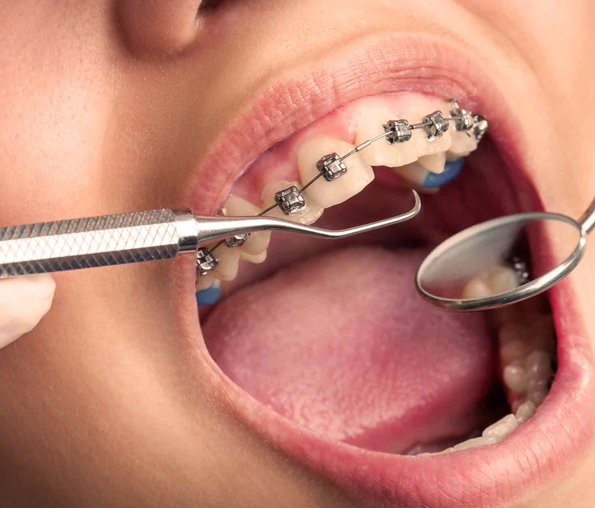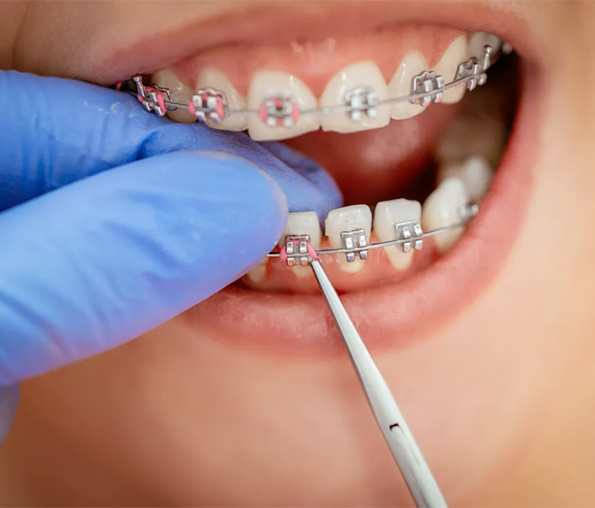Office Address
MEHTA CLINIC, Meeranangar, Shobhagpura, 100ft Road, Udaipur (Raj.) 313001

Orthodontic treatment is a specialized branch of Dental Services that focuses on correcting misaligned teeth and jaws to improve oral health, functionality, and aesthetics. It is not only about achieving a beautiful smile but also about ensuring overall oral well-being. Orthodontic treatment is recommended for various individuals, encompassing children, teenagers, and adults, who exhibit specific dental conditions that can benefit from corrective procedures. The need for orthodontic treatment arises from diverse factors, including dental misalignments, malocclusions, or jaw irregularities that can impact oral health, self-confidence, and overall quality of life.
Firstly, children often require orthodontic treatment to address dental issues that may affect their oral development. Early intervention is crucial as it can prevent more severe problems later in life.Conditions such as crowding, protruding teeth, crossbites, underbites, and overbites are common among children.
Orthodontic treatments like braces, expanders, or space maintainers are employed to guide proper tooth eruption, correct misalignments, and promote healthier dental growth.
Teenagers constitute a significant demographic for orthodontic treatment due to the prevalence of issues related to dental alignment during adolescence. This is the ideal age for orthodontic intervention as the bones are still developing, making it easier to adjust the teeth and jaws. Braces are commonly used during this phase to correct misalignments, close gaps, and improve the bite. The desire for an aesthetically pleasing smile also drives many teenagers towards orthodontic treatment, boosting their self-esteem and confidence.
Moreover, adults also seek orthodontic treatment for various reasons. While it may seem that orthodontic procedures are primarily for younger individuals, many adults realize the importance of correcting misaligned teeth and jaws for both functional and cosmetic reasons. Adults may have had untreated dental issues from childhood or may have experienced relapse after prior orthodontic treatment. Misalignments, crowded teeth, bite problems, and jaw irregularities can cause oral discomfort, difficulty chewing, speech impediments, and even contribute to oral health issues like gum disease and tooth decay. Therefore, adults opt for orthodontic treatments such as braces, clear aligners, or retainers to enhance their oral health and regain confidence in their smile.
The necessity for orthodontic treatment stems from various dental conditions and malocclusions that can adversely impact oral health and overall well-being. Malocclusions, which refer to misalignments of the teeth and jaws, can cause functional problems such as difficulty chewing, speaking, and maintaining proper oral hygiene. Crossbites, overbites, underbites, and open bites are common malocclusions that require orthodontic intervention to prevent issues like excessive wear on teeth, jaw pain, and increased susceptibility to dental problems.
Furthermore, orthodontic treatment is essential in cases where misalignments or irregularities pose a risk to oral health. Crowded or overlapping teeth are difficult to clean properly, leading to plaque accumulation, which can result in tooth decay, gum disease, and other oral infections. By aligning the teeth properly through orthodontic treatment, individuals can improve their oral hygiene and reduce the risk of developing these dental issues.
Beyond the physical aspects, the psychological impact of orthodontic treatment cannot be overlooked. Many individuals, especially teenagers, may experience low self-esteem and lack confidence due to their dental imperfections. Correcting these issues through orthodontic treatment can significantly boost self-confidence, enhance social interactions, and positively impact mental well-being.
In conclusion, orthodontic treatment is necessary for individuals of various ages who experience dental misalignments, malocclusions, or jaw irregularities. Whether it's children needing early intervention for proper oral development, teenagers seeking aesthetic improvements and functional corrections, or adults addressing oral health issues and regaining confidence, orthodontic treatment plays a crucial role in enhancing oral health and overall well-being. The advancements in orthodontic technology, such as clear aligners and improved braces, have made these treatments more accessible and comfortable, catering to the diverse needs of individuals seeking to achieve a healthier, more aligned smile.
Get Your Quote Or Call: 9024868258

Orthodontic treatment is a beneficial process aimed at correcting misaligned teeth and jaws, improving oral health, functionality, and aesthetics. While the primary goal is to achieve a beautiful and healthy smile, many individuals considering orthodontic treatment often wonder about the discomfort or pain associated with the procedures. Understanding the potential discomfort and pain levels throughout orthodontic treatment is crucial for individuals seeking these corrective measures.
Recognizing the signs indicating the need for a root canal is The commencement of orthodontic treatment, such as getting braces or clear aligners, may involve some initial discomfort or soreness. This discomfort typically arises as the teeth and surrounding oral structures adjust to the new
appliances.During the initial days after braces or aligners are placed, individuals may experience
soreness or tenderness in the teeth and gums as they gradually adapt to the pressure applied for
teeth movement.
Mild discomfort is a common occurrence and is usually manageable with over-the-counter pain
relievers like ibuprofen or acetaminophen. Additionally, orthodontic wax can be applied to the
braces' brackets or wires to alleviate irritation or rubbing against the oral tissues, reducing
discomfort.
Throughout the course of orthodontic treatment, periodic adjustments to braces or aligners are
necessary to facilitate tooth movement. These adjustment appointments may cause some discomfort for
a brief period, especially after the wires are tightened or when new aligners are placed.
After an adjustment, individuals might experience increased pressure or soreness in their teeth as
the orthodontic appliances exert force to shift teeth into the desired positions. This discomfort
typically diminishes within a few days as the teeth adapt to the new pressures exerted by the braces
or aligners.
During times of increased discomfort, adhering to a softer diet can help alleviate the soreness by
reducing the pressure applied to the teeth while chewing. Opting for foods that are easier to chew,
such as yogurt, mashed potatoes, soups, or smoothies, can provide relief during periods of
heightened discomfort.
Maintaining excellent oral hygiene is crucial throughout orthodontic treatment to prevent potential
issues. Proper brushing, flossing, and using orthodontic-friendly tools recommended by the
orthodontist help in reducing discomfort caused by oral irritation or inflammation.
Different orthodontic appliances might cause varying levels of discomfort. Traditional metal braces
might initially cause more discomfort due to their brackets and wires. However, advancements in
orthodontic technology have introduced options like ceramic braces or clear aligners, which may
offer a more comfortable experience for some individuals.
With clear aligners, users may experience minor discomfort during the initial days of each new tray
as it exerts pressure on the teeth to facilitate movement. Yet, the absence of wires and brackets
often results in fewer instances of oral irritation compared to traditional braces.
Orthodontists provide guidance and recommendations to manage discomfort during treatment. Applying
orthodontic wax to braces' brackets, using over-the-counter pain relievers, and consuming soft foods
can help ease discomfort.
Regular communication with the orthodontist regarding any persistent or severe discomfort is
essential. They can provide additional solutions or adjustments to alleviate pain and ensure the
treatment progresses comfortably.
While orthodontic treatment may entail some discomfort or mild pain at times, it's important to
acknowledge that the long-term benefits significantly outweigh these temporary issues. The improved
oral health, corrected misalignments, enhanced functionality, and aesthetic improvements obtained
through orthodontic treatment contribute to an individual's overall well-being and confidence.
In conclusion, orthodontic treatment might involve some discomfort or mild pain, particularly during
the initial phases and after adjustments. However, these discomforts are generally manageable and
temporary. By following the orthodontist's guidance, maintaining good oral hygiene, and
communicating any concerns, individuals can effectively manage the discomfort and focus on the
long-term benefits of achieving a healthier and more aligned smile.
Root canal treatment, or endodontic therapy, saves infected teeth by removing damaged pulp, cleansing the tooth, and sealing it.
Read MoreDental implants use titanium posts in the jawbone for durable, natural-looking replacement teeth or bridges.
Read MoreCrowns and bridges enhance smiles by covering damaged or missing teeth, and improving appearance,confidence.
Read More"Smile designing improves appearance via whitening, veneers, orthodontics, aligning with facial features, enhancing confidence, and personality."
Read More"Teeth whitening removes stains, restores brightness, enhances aesthetics, and boosts self-confidence."
Read More"Routine teeth cleaning removes plaque, tartar, stains, preserving oral health, preventing gum disease, and refreshing smiles."
Read More"Fillings repair cavities, bondings fix chips/gaps, enhancing tooth function, aesthetics for a natural, durable smile."
Read MoreMEHTA CLINIC, Meeranangar, Shobhagpura, 100ft Road, Udaipur (Raj.) 313001


